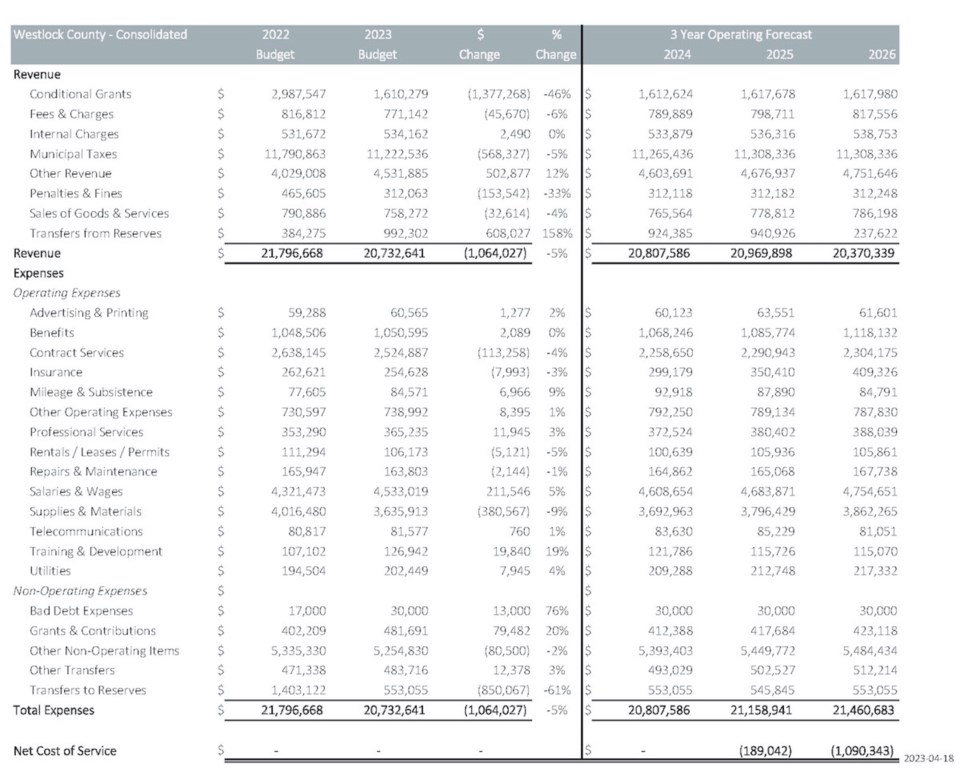WESTLOCK – Westlock County councillors have unanimously approved the municipality’s 2023 mill rate bylaw as well as the final operating budget, a document previously described as “bold” that includes a five per cent cut to expenses, double-digit decreases to the farm and non-residential mill rates, a 1.01 per cent increase to the residential mill rate and also gets the municipality back in alignment with the Municipal Government Act (MGA) with a 5-1 non-residential to residential tax rate.
With no debate at their April 26 regular meeting, councillors unanimously passed the two documents on recommendation from finance director Peggy Hardinge — following four hours of public and in-camera deliberations at their Dec. 13, 2022, meeting, plus three previous days of budget talks, councillors voted 7-0 to pass the interim operating budget. The updated document approved last Tuesday, and previously viewed at the April 19 committee of the whole meeting, counts $20,732,641 in expenses and revenues along with $11,217,376 in taxes, roughly $568,000 less than what was collected in 2022, plus $418,686 in provincial Municipal Sustainability funding and $1.1 million in transfers from reserves.
While the coming tax decrease has been previously covered in depth, of note is that the non-residential mill rate will drop by 12.6 per cent which gets the county in alignment with the 5-1 non-residential to residential tax rate as dictated under the MGA — an April 25 letter from reeve Christine Wiese to Alberta Municipal Affairs minister Rebecca Schulz highlighted the fact that they “have been working diligently on our 2023 operating and capital budget to bring Westlock County into compliance.”
“I just want to say great job and I’m looking forward to passing this and the letter also. We should frame it,” said Coun. Isaac Skuban.
“Thank you council and thank you so much director Hardinge and all your staff. I know you said it’s a collaboration that makes this happen,” added reeve Christine Wiese.
CAO Tony Kulbilsky called the council approvals the “final step” and wanted to make sure the letter was included “to officially tell the minister that they’ve taken care of the issue and they’re not looking back.”
“It’s a pretty strong statement and it will never be my recommendation to not be compliant with MGA. Everyone is pretty proud of the work we did collectively to get here,” said Kulbisky in an April 26 interview.
As previously reported, following passage of the interim budget in December, tax-wise, the 1.01 per cent residential mill rate increase means an “average homeowner” will pay about $22 more in 2023, while the farm mill rate is touted to drop by 10.7 per cent, which adds up to a reduction of $70 per year, per quarter section. Meanwhile, a non-residential assessment of $500,000 at the 2022 rate of 28.6087 versus the 2023 rate of 25 mills will see a reduction of $1,805 as for every $100,000 of assessment, the tax levy would be reduced by $360.
The final 2023 municipal tax rate for all residential classes is 5.245 mills, while farmland residential is 6.4 and all other classes, including farmland, non-residential and linear, is 25 mills. Meanwhile, the Homeland Housing mill rate is .6429, while the school requisition for residential and farmland is 2.5639 and jumps to 3.8108 for non-residential and linear. Simply, what a person pays in property tax on their home or business is the mill rate, multiplied by the value of their property, then divided by 1,000.
A “bold strategy”
A Dec. 14, 2022, county news release called the operating and capital budgets “bold” and “disciplined” and aimed to keep the “tax rates competitive while continuing to fund important investments in regional infrastructure” — Wiese previously noted the reductions were to “encourage further business development with who we currently have and also to bring more people to Westlock County.”
Kulbisky agrees, adding that “you set the climate for growth to occur” and said they’re getting “hot leads of people wanting to relocate or create their business opportunities here.” In a past interview he did admit that double-digit tax rate reductions aren’t the norm, but since he started with the municipality at the end of August 2022 he “looked for efficiencies” and asked “staff how we could do things differently” to make the operation “more efficient, without impacting service levels.”
The December release notes that “council’s goal in reducing the non-residential mill rate” was achieved by a short-term, drawdown of reserves, with a long-term goal of “encouraging and promoting investments in Westlock County’s non-residential property.”
“We want to build the momentum and create the climate for people wanting to do business here and we’re starting to see that happening. It’s too soon to talk about it, but we’ll be doing some sod-turnings soon,” he teased.
Kulbisky has said that drawing from reserves for at least the next handful of years will allow them to provide a “competitive tax rate for farm and non-residential” and ensure “that we can maintain service levels for residents and move the county forward by being investment ready.”
As it stands, a little over $900,000 in operating reserves will be used annually in 2024 and 2025 to balance the budgets, then will drop to $237,622 in 2026.



